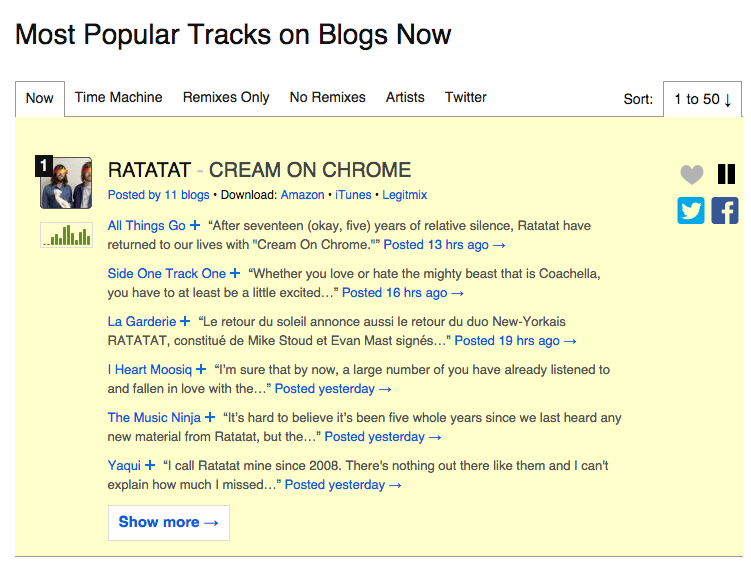The last decade has seen a core shift in the way music is discovered. Do you know why?
The power to break a new artist has slowly, but steadily, concentrated into the dense network of music blogs online. The promotional power of this network is matched only by mainstream radio, but with an important difference: almost everyone has an equal shot at getting into the blogs, while the same is decidedly untrue of mainstream radio.
The blog effect has become a common story: a new act is discovered by a tastemaker, who spreads it across the blogs online, culminating in thousands of plays and a deal with a major label.
But as an artist, it’s not always easy to get in the door. The best way to get onto music blogs, as in most other areas of the music industry, is through a personal relationship with the blogger or by working with a PR firm or label who has that relationship. What if you don’t have these relationships on your side?
Luckily, you can do the legwork yourself. This post will walk you through the steps you need to take in order to successfully pull off a blog launch campaign for your new track. First, I’ll walk you through some general insights, from editors at Pigeons and Planes, Earmilk, and others. Then, I’ll make sure you have all the right materials, get a strong list of blogs to target, and are ready to execute your campaign.
Let’s get started.
Music bloggers can receive hundreds of submissions every day. You’re competing with an avalanche of other artists fighting for a limited slot in your blogger’s attention span. It’s not an easy task.
So make it as easy as possible for a music blogger to choose your music. That means selecting only your very best — never, ever a rough or demo — and attaching it conveniently. The best route is to link to the Soundcloud track, with a Dropbox download link as backup.
You only get a few seconds to make an impression. Make sure to choose your very best track. If you’re serious about making it onto the blogs, then consider getting a professional mixing and mastering job. They’re expensive, but you immediately come across as professional.
When you only have a few seconds to capture the attention of a blogger, and you’re fighting against hundreds of other artists, a professional mix can be the defining difference.
On the other side of your email is a living, breathing human being. People are built to be captivated by interesting stories. So share yours! Tell a short story about your history and who you are.
Good candidates are the story of the album, the inspiration for your music, or your story as an artist. Bad candidates include “X producer is interested in me,” “I’m redefining the genre,” or any other form of overt bragging.
Remember, you’re telling this story to a blogger with just a few seconds of time. Be genuine and be brief.
Blogs survive on traffic, so they’re looking for acts that are likely to bring a lot of interest into the future — they’re looking for professionals. The easiest way to be rejected is to ignore aesthetics. Bad design, writing, or production all scream amateur.
Be professional. This includes ensuring proper spelling and grammar across your materials. It means your website (if you have one) is well-designed, your photos are professional and your album art was certainly not done in Paint. Everything you put out broadcasts a message about you. Make sure it’s the right one.
If you can’t afford designers, artists, and photographers, you can still get close to the real thing using cheap or free tools:
- Use a friend’s camera with filters to approximate professional photos
- Build your website with Squarespace
- Find a cool photo on Unsplash and overlay an interesting font like Avenir or Lato for your album cover
- Host all your music on SoundCloud
- Set up a Gmail account with your artist name, such as [email protected]
Bloggers are highly sensitive to bullshit — a side effect of receiving so many music submissions each day. If they sense a form email, you’ve lost your shot.
Personalize the emails you send. Mention the writer by name, include the name of the blog, and if they’ve written about artists similar to you in the past, reference those artists. This doesn’t mean sucking up; it just means making it clear that you’re not putting them on blast.
From Alice Currier
"I look for personalized (not form-filled) emails that tell me a little bit about their back story. Plain English, working links."
– Nathan Beer (Earmilk)
"If you’re a struggling artist, then sending out something generic seems lazy, and I feel less inclined to check it out. A personalized email…will fare much better because it seems like an effort was made to contact me."
– Kristi Shinfuku (Earmilk)At the end of the day, your email is going to land in an overwhelmed blogger’s inbox along with a hundred other submissions. Unless you have a personal relationship with the blogger or you’re The Weeknd, it’s likely your outreach will simply fall through the cracks.
This is normal. Don’t be disheartened.
This is why you need to be prepared for your outreach campaign. First, you need to have a list of bloggers to reach out to — not just one or two, but closer to one hundred. Second, you need to have a strategy for following up on your submissions. If you don’t cut through the noise the first time, try again.
Follow the rule of 3: after three emails without a response, give it up. Any more and you risk crossing the line into spam and getting blocked. Keep the channel open for your next track.
Preparation is harder than it sounds. In order to help you make the most of your outreach campaign, I’ve created a short guide to preparing for your campaign.
Before you reach out to blogs, you’ll need some basic materials.
- Short bio
- At least one HD photo
- Your best song, streaming on Soundcloud
- A link to your website
- Your contact details
Remember rule #3! Aesthetics matter. Be professional.
This is by far the hardest part of the process, but it’s also the most important. Your legwork here will make or break your entire campaign. Try to put together one hundred blogs to reach out to. Focus on blogs which have posted songs in your genre in the past as much as possible; there’s no use wasting time on blogs who clearly have a mismatched audience.There are many ways to find blogs to target, but I’m going to share my two favorite methods.
Hype Machine
Hype Machine has long been the king of blog aggregators. It lists the top songs being posted on music blogs across the Internet — which means it’s posting the top music blogs.The process is simple. Search for your genres, or for artists similar to your sound. Underneath the posted songs, you can expand all the blogs who posted the content. These should be added to your target list.

Reverse Image Lookup
Google’s reverse image lookup is one of the best ways to find music blogs — and one of the least-known methods. Here’s how to pull it off:
- Search for artists similar to your sound and look for their image.
- Drag it onto the search bar to perform the reverse lookup.
- Voila! You have a list of blogs who have posted that artist in the past, and you know the writer who posted it. Add these to your list.
In order to organize your campaign, you’ll need to keep track of who you’re reaching out to, whether or not they’ve responded, and who you need to follow up with. The easiest way to do this is with a spreadsheet, in Excel, Numbers, or Google Sheets.
Make these columns:
- Blog name
- Writer name
- Contact email address
- Additional notes (for any special submission requirements)
- Date of First Email
- Response
- Date of Second Email
- Response
- Date of Third Email
- Response
Most of these fields are straightforward. The six email fields are dedicated to your initial reachout and followups. If your first email results in a feature — awesome! Record the response and keep that blog in mind for the future. Send a thank-you, and clear it out – you don’t need to follow up. If you receive a refusal, then you can schedule to follow up in two weeks. And if you receive no response, then follow up in a week.
Remember the rule of three — no more than 3 emails should be sent to a blogger.
Now for the fun part!
It’s time to hit your target list. Now, unless you have reasonable belief that you will land an exclusive with a meaningful blog, don’t bother going after exclusives. As noted by Ryan Holiday, the media reacts according to the old adage: where there’s smoke, there’s fire.
Let’s make some smoke.
Aim to have your track up and all your materials ready by a pre-determined time. Then, reach out to all of the bloggers on your list as quickly as possible.You can do this by saving draft emails to everyone, at which point you go through and send all your drafts. Or you can pick up Boomerang and schedule out all of the emails in advance.
This is the fun part. Send your emails, see what results you get, and don’t forget to follow up.
Good luck!

